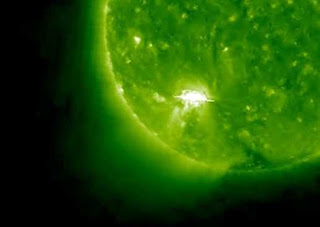For decades, experts have searched for signs in the sun that could lead to more accurate forecasts of
solar flares — powerful blasts of energy that can supercharge Earth’s upper atmosphere and disrupt satellites and the land-based technologies on which modern societies depend. Now a scientist at NOAA’s Space Weather Prediction Center and her colleagues have found a technique for predicting solar flares two to three days in advance with unprecedented accuracy.
The long-sought clue to prediction lies in changes in twisting magnetic fields beneath the surface of the sun in the days leading up to a flare, according to the authors. The findings will be published in
Astrophysical Journal Letters next month
.
“For the first time, we can tell two to three days in advance when and where a solar flare will occur and how large it will be,” said lead author Alysha Reinard, a solar physicist at NOAA’s Space Weather Prediction Center and the Cooperative Institute for Research in the Environmental Sciences, a partnership between NOAA and the University of Colorado.
The new technique is already twice as accurate as current methods, according to the authors, and that number is expected to improve as they refine their work over the next few years. With this technique, reliable watches and warnings should be possible before the next solar sunspot maximum, predicted to occur in 2013. Currently, forecasters see complex sunspot regions and issue alerts that a large flare may erupt, but the when-and-where eludes them.
Solar flares are sudden bursts of energy and light from sunspots’ magnetic fields. During a flare, photons travel at the speed of light in all directions through space, arriving at Earth’s upper atmosphere—93 million miles from the sun—in just eight minutes.
Almost instantly the photons can affect the high-orbiting satellites of the Global Positioning System, or GPS, creating timing delays and skewing positioning signals by as much as half a football field, risking high-precision agriculture, oil drilling, military and airline operations, financial transactions, navigation, disaster warnings, and other critical functions relying on GPS accuracy.
“Two or three days lead time can make the difference between safeguarding the advanced technologies we depend on every day for our livelihood and security, and the catastrophic loss of these capabilities and trillions of dollars in disrupted commerce,” said Thomas Bogdan, director of NOAA’s Space Weather Prediction Center.
Reinard and NOAA intern Justin Henthorn of Ohio University pored over detailed maps of more than 1,000 sunspot groups, called active regions. The maps were constructed from solar sound-wave data from the National Science Foundation’s Global Oscillation Network Group.
Reinard and Henthorn found the same pattern in region after region: magnetic twisting that tightened to the breaking point, burst into a large flare, and vanished. They established that the pattern could be used as a reliable tool for predicting a solar flare.
“These recurring motions of the magnetic field, playing out unseen beneath the solar surface, are the clue we’ve needed to know that a large flare is coming—and when,” said Reinard.
Rudi Komm and Frank Hill of the National Solar Observatory contributed to the research.
NOAA understands and predicts changes in the Earth's environment, from the depths of the ocean to the surface of the sun, and conserves and manages our coastal and marine resources. Visit us on
Facebook.
Note to Editors: The paper has been accepted for publication in
Astrophysical Journal Letters in February: “Evidence that temporal changes in solar subsurface helicity precede active region flaring,” by Alysha Reinard, Justin Henthorn, Rudi Komm, and Frank Hill.


















